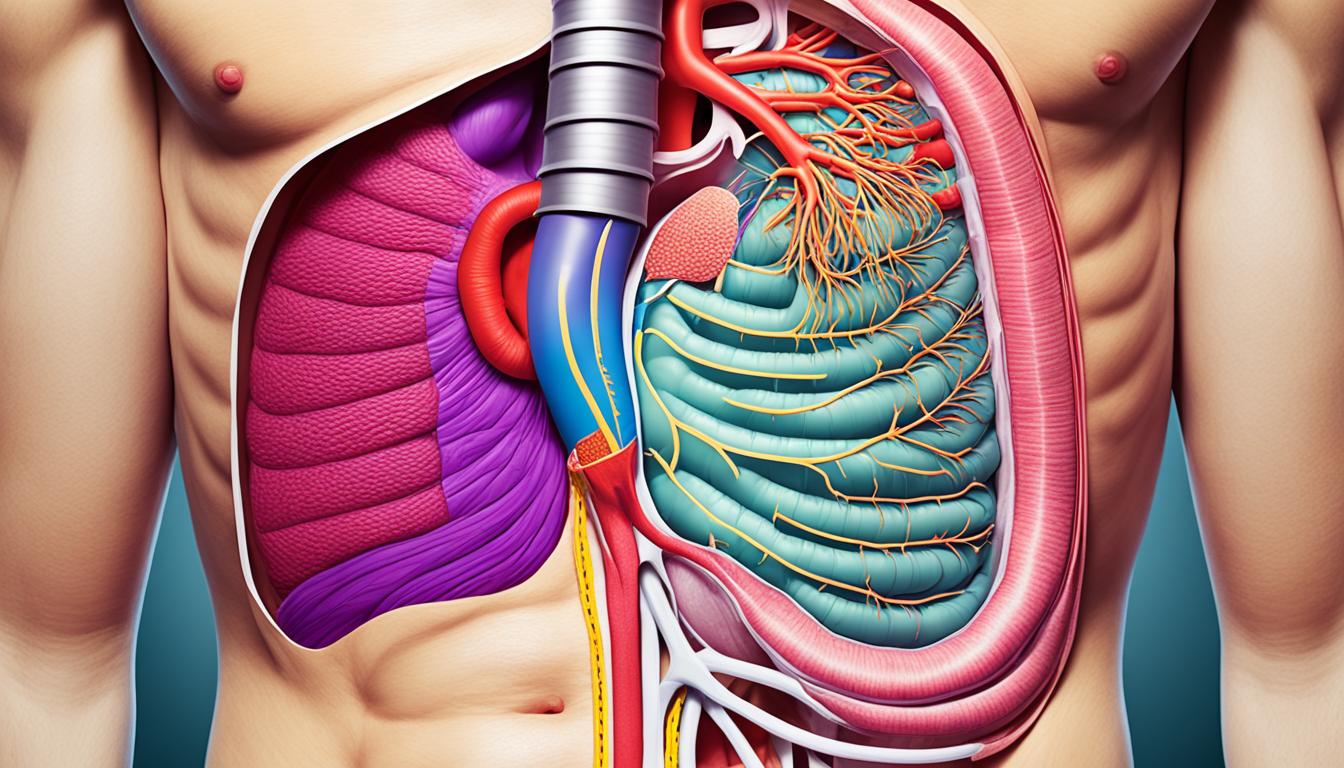A hiatal hernia happens when part of the stomach pushes up through the diaphragm. The diaphragm is the muscle that separates your chest from your stomach. This can cause heartburn, acid reflux, and pain when swallowing. Things like being overweight, pregnant, or having a family history can increase your risk of getting a hiatal hernia. Doctors will do special tests like an upper GI swallow study or an endoscopy to find out if you have one.
There are a few ways to treat a hiatal hernia. Medicine, changing your diet, and exercises can help. Sometimes, if the hernia is severe, you might need surgery. But recently, doctors are looking into using stem cells to treat hiatal hernias. This could be a new and exciting way to help people with this condition. However, more studies are needed to make sure it is safe and works well.
Key Takeaways:
- Hiatal hernia is when the stomach pushes through the diaphragm’s opening.
- Its symptoms are heartburn, acid reflux, and trouble swallowing.
- Being overweight, having kids, or certain illnesses can make you more likely to get one.
- Doctors use tests like an upper GI study to check for hiatal hernias.
- Treatments include medication, diet changes, and possibly surgery.
- Stem cell therapy might become a new option for treating hiatal hernias, pending more research.
Understanding the Types of Hiatal Hernia
Hiatal hernias come in different forms, each with unique features and risks. Knowing the types helps people understand their condition better. This knowledge is important for deciding on the best treatment. We will look at sliding, paraesophageal, mixed, and giant hiatal hernias.
1. Sliding Hiatal Hernia
Sliding hiatal hernias are the most common. The area where the esophagus meets the stomach moves up into the chest.
They might cause acid reflux, heartburn, or chest pain. But, they usually don’t cause big problems or need surgery right away.
2. Paraesophageal Hiatal Hernia
Paraesophageal hernias are different. The top of the stomach sticks out next to the esophagus, while the junction stays in place.
This type has more risks, like twisting of the stomach or its blood supply getting cut off. Symptoms can be strong pain, trouble swallowing, and vomiting.
3. Mixed Hiatal Hernia
Mixed hiatal hernias show features of both sliding and paraesophageal types. Parts of the stomach move up by the esophagus.
They might cause problems similar to paraesophageal hernias. Sometimes, they need surgery to fix.
4. Giant Hiatal Hernia
Giant hernias are not common. They involve a big part of the stomach moving into the chest through the diaphragm.
They might cause issues like swallowing problems, chest pain, or stomach discomfort. The risk of serious complications is high.
In short, hiatal hernias can be sliding, paraesophageal, mixed, or giant. Sliding hernias are often less risky. But, paraesophageal and giant hernias have more complications. Knowing the specific type of hernia helps in choosing the right treatment and managing risks.
Symptoms, Risk Factors, and Diagnosis of Hiatal Hernia
A hiatal hernia can change life by causing various symptoms. You may experience heartburn, acid reflux, or find it hard to swallow. There might also be chest or belly pain, with breathing difficulties or unusual stool colors.
It’s crucial to recognize these signs and get help if they keep happening or get worse.
Several things can make a hiatal hernia more likely. These include age, obesity, and smoking. Having a family member with this issue also increases your risk.
Finding out if you have a hiatal hernia involves tests to check its size and impact. Doctors may use X-rays, a tube with a camera to look inside, or a test to see how well your esophagus muscles work.
| Diagnostic Test | Purpose |
|---|---|
| Upper GI swallow studies | Visualize the esophagus, stomach, and upper small intestine. |
| Upper endoscopy | Direct visualization of the esophagus and stomach. |
| Esophageal manometry | Assess the strength and coordination of esophageal muscles. |
Innovative Treatment Options for Hiatal Hernia
Treating a hiatal hernia depends on its size and how much it bothers you. If it’s not making you feel bad, doctors might suggest just keeping an eye on it. This is a good plan for people who feel fine most of the time and don’t have much discomfort.
If you also have acid reflux, some lifestyle changes and medicines can help. Medicines prescribed by a doctor can lower stomach acid. You can also feel better by staying at a healthy weight, not eating foods that make you feel worse, and sleeping with your head raised.
If these steps don’t work, you might need surgery. There are different surgeries for hiatal hernias. Doctors might do fundoplication or toupet fundoplication to fix the hernia. These surgeries stop the stomach from moving into the chest. The right surgery for you depends on what your doctor thinks and on your health.
Stem cell therapy is a new treatment option for hiatal hernias. It uses stem cells to fix the hole in the diaphragm. This is where the stomach comes through. While this sounds very hopeful, we still need more studies to know if it really works long-term. Always talk to a specialist to get advice tailored to you.

